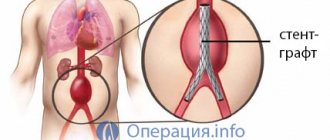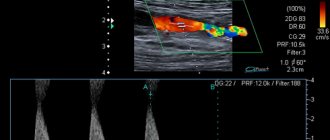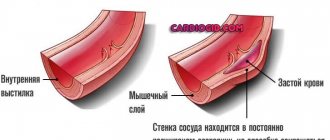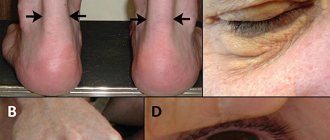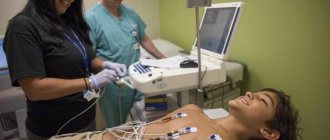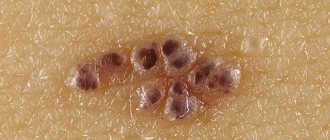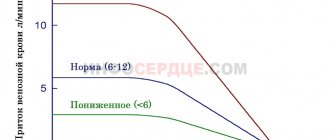Who is cauterization indicated for?
Nasal bleeding occurs in different parts of the nasal cavity. If during bleeding from the anterior section the volume of discharge is minimal, then discharge from the posterior section occurs when large blood vessels are damaged and is accordingly characterized by a large volume. It is the second type of bleeding that can often be treated with cauterization.
However, this procedure can also be done in case of discharge from the anterior section if there are objective indications. In addition, the procedure makes sense in the event of other ailments that result in pathological processes in the mucous membrane. Using cauterization, it is removed partially or completely.
In the absence of results of loyal treatment, the indications for the procedure are as follows:
- periodic nosebleeds that cannot be treated conservatively;
- chronic rhinitis and sinusitis;
- inflammatory diseases of the nasal cavity, for example, hypertrophic rhinitis;
- chemical damage to the nasal mucosa, for example, in the form of vasomotor medicinal rhinitis;
- mucosal atrophy;
- difficulty breathing of various etiologies;
- sometimes - in preparation for rhinoplasty.
Cauterization of vessels in the nasal cavity has the following advantages:
- Effectiveness in eliminating ENT pathologies, which result in constant nasal congestion and periodic bleeding.
- The duration of the process, which does not exceed half an hour (sometimes lasts up to 10 minutes).
- The level of complexity of the procedure does not imply further inpatient treatment and round-the-clock monitoring. If there are no complications at the end of the operation, the patient is sent home for further recovery.
- The procedure is well tolerated: there is no pain for the patient, the treated area, as a rule, does not bleed.
- Minimal recovery time and no side effects, such as swelling.
However, taking the measures discussed on your own is prohibited. After unsuccessful therapeutic treatment, the procedure will be as follows:
- Examination by an ENT specialist who, based on the existing pathology, will select the best option for influencing the mucous membrane and blood vessels.
- Additional tests for laboratory research.
- Based on the overall picture of the examinations obtained, the day of the surgical operation is scheduled.
- Direct execution of the chosen surgical option.
Consequences of the procedure
For a successful outcome of the intervention, it is necessary to adhere to all the recommendations of the attending physician, and also follow several rules:
- avoid straining the nasal bone,
- do not injure the inner surface of the nasal cavity,
- Do not remove cortical formations yourself,
- don't blow your nose.
However, some complications are possible:
- the risk of trauma to the nasal sinuses increases due to the use of chemicals and swelling of the mucous membranes. Congestion occurs, which quickly goes away if you follow the doctor’s recommendations.
- pain is most typical for electrocoagulation and cauterization with silver nitrate
- provoking the opening of re-bleeding when independently removing the formed crusts at the cauterization site. It is necessary to comply with all rehabilitation conditions for the speedy restoration of the mucous epithelial cover.
High-quality and timely diagnosis will allow you to reasonably carry out the procedure of cauterization of blood vessels in the nose and get rid of unpleasant symptoms once and for all. Strict compliance with all rules and compliance with standards by the medical worker and the patient is the key to a successful surgical operation.
Cauterization of nasal cavity vessels in ON CLINIC
Cauterization of a bleeding vessel in the nasal cavity is indicated for relapses, after a thorough diagnosis and the absence of contraindications to the chosen method of therapy. It is carried out using electricity (electrocoagulation), laser and ultrasound. Cryodestruction is also used - treating vessels with a cooling agent, most often liquid nitrogen. Local anesthesia is used for pain relief.
Before the intervention, the ENT doctor will definitely conduct a diagnosis and check blood clotting. An ultrasound of internal organs may also be required. Since we have a clinical diagnostic laboratory, you will receive test results quickly, within an hour after submitting the biomaterial.
There are no queues at ON CLINIC! When you call our clinic, the administrator will ask you to choose a time that will be most convenient for you. All of our staff are always polite and friendly, and the high professionalism of ENT doctors is confirmed not only by the large number of positive reviews from patients, but also by regular requests for help and advice from colleagues from other clinics.
Preventing nosebleeds
Preventing frequent nosebleeds involves first identifying contributing factors (deviated septum, high blood pressure, or tumors). In addition, concomitant causes of bleeding may be dry air, vasoconstrictor drugs, trauma and pressure surges).
Preventive measures include all possible actions and means aimed at combating the causes of the pathological process. It is necessary to minimize the risk of developing nosebleeds in every possible way.
If you are suffering from frequent nosebleeds, then it is better to make certain observations before visiting a specialist and determine at what time of day the bleeding mainly occurs, whether there are clots in it, and what is the frequency of such bleeding. And most importantly, you need to check whether the blood stops on its own or whether your actions are necessary for this to happen.
Nosebleeds are a common phenomenon that occurs in both adults and children. As a rule, in most cases they do not attach importance to it and do not contact an ENT doctor about this. And this is fundamentally wrong. There are often cases when blood loss becomes more abundant and can amount to up to 20 percent or more of all blood circulating in the body.
Frequent occurrences may indicate serious illnesses that require immediate treatment. If you or your children or relatives often have nosebleeds, contact the ON CLINIC International Medical Center, where they will conduct a diagnosis on the day of your visit and identify the cause of the disorder.
Don't risk your health. It is much better to take some time for yourself, contact an otolaryngologist and, if necessary, undergo a course of treatment, than to remain in the dark, aggravate the course of the disease, or try to use traditional and often dangerous methods to stop nosebleeds. Call ON CLINIC right now and make an appointment!
The administrator will contact you to confirm your appointment. IMC "ON CLINIC" guarantees complete confidentiality of your request.
Possible complications
- Nasal congestion. This complication does not occur often, but it does happen. Symptoms may not only not disappear, but also appear even stronger. The cause is often an allergic reaction or repeated hypertrophy.
- Problems with smell. In most cases, this complication is temporary and manifests itself due to swelling after the manipulations.
- Inflammatory process. Cauterization is a surgical procedure, so the body becomes more susceptible to various bacteria and viruses. The possibility of infection through an instrument cannot be ruled out if it is not sterile.
- Tissue atrophy. This phenomenon is the flip side of hypertrophy. Atrophy may occur due to the destruction of some important cells in the epithelium of the nasal passages.
- The appearance of adhesions. This may cause difficulty breathing. This problem can be eliminated only by performing another operation.
The cost of such operations
Heart cauterization operations are performed in Russia, but many prefer to be treated abroad. The most popular clinics for this are Germany and Israel. They use the most modern equipment, and doctors have extensive experience in performing such operations.
In Germany, excluding flights and accommodation, you will have to spend about 2-3 thousand dollars for diagnostics and about 25 thousand dollars for surgery. Among the clinics that perform heart cauterization surgery are the St. Helena Clinic in Essen, the St. Joseph Clinic in Bochum and the private cardiology clinic of Professor Nixdorf in Düsseldorf.
In Israel, diagnosis and treatment are somewhat cheaper, typically 30 to 50 percent. That is, treatment in Israeli clinics can amount to up to 20 thousand dollars.
Treatment of arrhythmia using cauterization will be cheaper, not only due to the cost of the operation, but also due to a cheaper flight (if necessary)
In Moscow
In Moscow clinics, the cost of cauterization surgery is:
For atrial tachycardia – from 20 to 137 thousand rubles. For ventricular tachycardia – from 27 to 180 thousand rubles. For other diseases - from 30 to 290 thousand rubles.
The operation can be performed in the following clinics:
Name of clinic Address Price level relative to general indicators
| High | ||
| KB MSMU im. Sechenov | st. B. Pirogovskaya, 6, building 1 | Average |
| Research Institute of SP named after. N.V. Sklifosovsky | Bolshaya Sukharevskaya square, 3 | Low |
| GVKG im. Academician N.N. Burdenko | Hospital Square, 3 | Very low |
| Volyn hospital | st. Starovolynskaya, 10 | Low |
| Central Design Bureau No. 2 of JSC Russian Railways | st. Budaiskaya, 2 | Very low |
| FSCC FMBA | Orekhovy Boulevard, 28 | Low |
| Institute of Surgery | st. Bolshaya Serpukhovskaya, 27 | Low |
| State Clinical Hospital named after. S.P. Botkin | 2nd Botkinsky Prospect, 5 | High |
| State Scientific Research Center for Preventive Medicine | Petroverigsky lane, 10 | Low |
In St. Petersburg
In St. Petersburg clinics, the cost of cauterization surgery is:
For atrial tachycardia – from 20 to 137 thousand rubles. For ventricular tachycardia – from 27 to 180 thousand rubles. For other diseases - from 30 to 290 thousand rubles.
Name of clinic Address Price level relative to general indicators
| FMITs them. V. A. Almazova | st. Akkuratova, 2 | Average |
| St. Petersburg State Medical University named after. I, P. Pavlova | st. Lev Tolstoy, 6/8, building 16 | Low |
| Clinic named after Peter the Great | Piskarevsky Prospekt, 47 | High |
| Clinic named after E. E. Eichwald | st. Kirochnaya, 41 | High |
It should be noted that cauterization of heart tissue is carried out free of charge. To do this, you need to stand in line and wait for an invitation to the operation.
It is carried out in the city where the patient lives, if it has appropriate hospitals or clinics. In other cases, the patient can try to contact the nearest large city, where there are suitable equipment and specialists.
Varieties
Cauterization is performed only after conservative therapy has not brought the required positive result and restoration of the mucous surfaces of the nasal passages is possible only through surgical intervention.
There are several variations of surgical interventions. Each method has its own adherents and opponents. All methods are united by their safety for the patient’s health. Cauterization of blood vessels in the nose can be done in several ways. They are discussed in the table.
Laser cauterization as a method of combating chronic rhinitis.
| How is the procedure performed? | |
| Method | Description |
| Cauterization with laser (pictured) | Provides a targeted effect on the affected area. It has an easy postoperative period. The price of the intervention is affordable, the method is widespread at present. |
| Radiosurgical method | The method does not cause injury to the patient’s mucous membranes and skin. The patient does not experience pain during the operation. |
| Cauterization with silver | The affected area is treated with a special solution. The patient does not experience pain or burning. The procedure lasts no more than 10 minutes. |
The procedure has the largest number of adherents when using a laser. However, the opinions of patients differ - some talk about the pain of the manipulation and the duration of the recovery period after it. And others claim that the process does not have any significant pain, and rehabilitation is quick.
However, all surgical options are more beneficial, since such interventions are characterized by:
- high speed of operation;
- there is no need for specific preoperative preparation;
- complications from the operation are minimal and unlikely;
- mucous membranes quickly regenerate.
The rehabilitation period after such treatment is purely individual, but the effectiveness of the methods is extremely high and practically does not depend on individual indicators.
How is coagulation performed when using a radiosurgical knife?
Optimal method
The radiosurgical knife is a thin rod that does not heat up. Manipulation with its use through the use of current heats and expands soft tissue cells. During this process, the liquid boils and evaporates.
Such coagulation does not cause injury to the external integument. After the manipulation, the patient does not feel pain, but the swelling of the treated area increases and an inflammatory process may develop.
Cauterization of nasal vessels using laser irradiation
In order to perform laser cauterization of nasal blood vessels, a specific device is required that delivers a laser beam of the required intensity. During the surgical procedure, the specialist controls the power of the laser effect and its nature.
The laser beam can be pulsed or point. It does not affect soft tissue and acts exclusively on the necessary damaged area.
Further bleeding after completion of the manipulation is excluded. During the operation, the patient is prohibited from moving his head and talking. The correct breathing of the patient is also monitored - it must comply with the rules.
How is the operation performed?
Laser surgery has certain advantages:
- no damage to the soft tissues of the nasal cavity;
- It is the causes that provoke a runny nose that are eliminated, and not just the symptoms;
- There is no significant pain during the operation;
- the duration of the event is minimal;
- No specific preparation is required for the operation.
Important! This technique can eliminate even a chronic runny nose, and the postoperative period and rehabilitation do not require excessive effort from the patient.
"Silver" cauterization
What is the advantage of using silver?
Benefits of laser surgery
Does laser surgery have benefits? Of course it does, and they are:
- damage to soft tissues in the nasal cavity is excluded;
- the causes of the runny nose are directly eliminated, and not the symptoms of this phenomenon;
- there are no bleeding wounds left in the nose;
- the possibility of infection is excluded;
- the effectiveness of getting rid of chronic runny nose is noted;
- tissues in the nasal cavity recover quickly after surgery;
- minor tingling during the procedure, not pain;
- The duration of the procedure is minimal, it does not require special preparation.
Indications and contraindications
Nasal breathing helps warm and clean the air. Therefore, its violation leads to a decrease in the quality of life and an aesthetic defect. Conchotomy is indicated in the following cases:
- hypertrophic form of rhinitis;
- vasomotor, allergic, medicinal rhinitis;
- obstruction of one or both nasal passages;
- adhesions;
- synechia;
- neoplasms (cysts, polyps, fibromas, papillomas).
The method has undeniable advantages, since only deformed areas are removed. Healthy tissues are not affected, which ensures rapid recovery. Conchotomy immediately eliminates the cause of nasal breathing disorders, and improvement occurs within the first day. The effect of such therapy lasts for a long time.
Laser treatment is not recommended during menstruation, in the acute phase of respiratory diseases, or in cases of blood clotting pathology. Relative contraindications are mental disorders, heart failure, respiratory system.
Cauterization is used in cases where drug treatment does not help. The procedure helps to expand the nasal passages and improves the outflow from the maxillary sinuses. The treatment method is determined by an otolaryngologist. To do this, you need to undergo an examination and take blood tests, urine tests, a swab from the nasal mucosa and pharynx for pathogenic microflora.
Indications for surgery
Coagulation of vessels in the nasal cavity is never carried out at the sole request of the patient - for this procedure there must be certain indications, which are established by the attending doctor. It is carried out only when conservative treatment methods have not brought the expected improvements. Therefore, the main indications for the procedure are the following patient conditions:
- Constant nosebleeds in severe form.
- Some chronic pathologies of the nose, for example, rhinitis, sinusitis or sinusitis.
- Difficulty nasal breathing.
Preparing the patient for nose correction, for example, rhinoplasty.- Relieving the patient of dependence on the constant use of nasal medications to improve breathing, the frequent use of which provoked rhinitis.
- Hypertrophy of the nasal mucosa as a result of constant use of vasoconstrictor medications.
- Respiratory dysfunctions caused by nasal pathologies.
- Often operations are performed for hypertension and weakness of capillary vessels, as well as if the patient is susceptible to serious allergies.
- With the help of cauterization, you can get rid of such an unpleasant phenomenon as constant dryness of the nose caused by external irritating factors (for example, dry air, dust or poor ecology).
As you can see, the main indications for the use of the procedure are various dysfunctions in the functioning of the nasal mucosa. However, before carrying out, consultation with a specialist is always required regarding the advisability of using the chosen coagulation technique.
Reasons for using coagulation
Clear evidence should provide justification for the procedure.
Symptoms for which surgery is prescribed:
- presence of frequent nosebleeds,
- constant bleeding that has reached a severe phase of development,
- atrophy of the mucous membrane due to chronic rhinitis,
- prolonged form of sinusitis or rhinitis,
- difficulty breathing as a consequence of developed pathological processes in the nasal cavity,
- complications caused by dilated vessels.
According to medical statistics, the procedure is prescribed in most cases due to frequent and incessant nosebleeds.
They are caused by the close location of blood vessels to the surface of the mucous membrane, thus being prone to frequent damage, which causes bleeding. In addition, such a predisposition may increase the likelihood of pathologies.
Children may be diagnosed with weak walls of the vessels of the nasal cavity. As a rule, everything falls into place with age and does not require treatment.
The clear advantages of coagulation are:
- impact on a specific affected area,
- high probability of successful treatment and low probability of re-bleeding,
- rehabilitation is possible at home without hospitalization,
- does not require lengthy preparatory stages or other manipulations,
- The remission period is quite short,
- rarely causes serious complications,
- There is no need for anesthesia, as local anesthesia is used.
Like any other surgical intervention, the procedure has some contraindications:
- presence of infection in the body,
- poor immune system condition,
- bleeding of various etiologies, including those caused by the use of medications.
Possible causes of bleeding
Children often experience this type of disorder.
When a patient experiences regular bleeding, it is difficult to determine the true cause of the pathological phenomenon. The reasons may be general or local.
System-wide factors that can potentially lead to nosebleeds are:
- Elevated blood pressure, combined with heart muscle defects. This is often observed in elderly patients whose blood vessels have lost their elasticity and become excessively fragile.
- Poor blood clotting indicators, which are combined with diseases such as anemia, thrombocytopenia, hemophilia.
- Sleep disturbances, frequent insomnia and stressful situations, possible overwork.
- Heat or sunstroke.
- An allergic reaction of the body to some irritant.
- Excessive dryness of the nasal mucosa.
- Hormonal imbalance.
Local causes of nasal bleeding may include the following:
- injuries to the nose, the cause of which lies in the mechanical impact on the organ;
- foreign body in the nasal tract;
- neoplasms of the nasal cavity;
- curvature of the nasal septum;
- burns of various etiologies.
Weakness of the mucous membranes as a cause of nosebleeds.
Attention! Manipulation in children is carried out after a full examination. The cause of bleeding in this case is often the weakness of the mucous membranes.
Burns that could potentially cause nasal bleeding may include:
- thermal;
- electric;
- chemical;
- ray.
The causes of local nosebleeds are quickly detected by a specialist and eliminated. The procedure is selected depending on the type of cause and type of bleeding.
How is the operation performed?
Among the many types of vasotomy, laser conchotomy is the most popular. Before the operation, consultation with an otolaryngologist is necessary. The doctor will examine the medical history and prescribe additional studies to exclude contraindications. A few days before the procedure, you should stop taking medications that thin the blood and drinking alcoholic beverages.
Stages of the procedure
Laser conchotomy is carried out in several stages.
Stage 1. The person is asked to change into a special sterile gown and sit on the operating table.
Stage 2. The patient's eyes are covered with a bandage, arms and legs are fixed with tourniquets.
Stage 3. Local anesthesia is performed, the face is treated with an antiseptic drug.
Stage 4. Excision of tissue with a laser is performed directly. The progress of the operation is monitored using a special surgical mirror.
The duration of such an intervention is 20-30 minutes, after which the patient is sent home.
Operation description
After a decision is made about the need for ablation, the patient is hospitalized 1-2 days before the intervention. Before the operation, an electrophysiological study is carried out, and the doctor draws up a chart of the operation.
The intervention is carried out in the operating room under constant x-ray control and monitoring of the patient's condition. General anesthesia is not used during the operation. This intervention is painless, the patient does not feel any specific sensations in the heart area, only mild discomfort is possible (this is rather a psychological factor). The patient has a catheter inserted into a large vein (usually the subclavian or femoral). This procedure itself is painful, so local anesthesia is used. Hemostatic sheaths are inserted through it to protect the blood vessels and conduct a “field” study.
Then the electrodes themselves are inserted. They are small and do not injure blood vessels. Under the control of an x-ray machine, they are delivered to the heart to the site of impact. At the place of work, the doctor creates a blockade so that the procedure itself does not cause arrhythmia.
If necessary, sedatives are administered. Then the cauterization itself begins: the electrodes emit a current of the required strength to affect selected areas. For a doctor, this is a complex, jewelry procedure. For the patient, it is an opportunity to rest and relax in anticipation of recovery.
The duration of the procedure is purely individual and depends on the complexity of the operation. The patient is conscious all the time; the use of medications during the operation is not required or is minimal. After the intervention, the patient can get up and walk, but other activities are temporarily prohibited. He should stay in the hospital for 1-2 days after the operation, discharge is carried out on the second day, sometimes the next. Usually there are no discomfort after cauterization.
Return to contents
Preparing for surgery
Before performing laser conchotomy of the turbinates, the specialist arranges a consultation for the patient, during which he explains the step-by-step procedure of the surgical intervention and the possible consequences.
Before laser destruction, women are limited in cosmetic procedures and do not use decorative cosmetics for several days.
He also prescribes a number of diagnostic studies and necessary tests. After which he schedules a second consultation to determine the date and time of laser coagulation. Patients are prohibited from using medications that thin the blood and drinking alcohol.
Recovery after the procedure
Vascular coagulation is not a very complicated procedure, but during the first 1-2 weeks after it a number of recommendations should be followed. They are aimed at faster tissue healing, preventing bleeding and exacerbations of the disease. Regardless of the chosen method of carrying out the operation, the instructions will be as follows:
- avoid visiting a bathhouse, sauna, swimming pool, as well as swimming in open and closed reservoirs;
- stop drinking alcohol;
- reduce physical activity, postpone training and try not to run;
- rinse your nose with regular saline solution or its analogues;
- moisturize the mucous membrane with neutral oils (you can use regular petroleum jelly or sea buckthorn oil).
It is important to avoid situations that increase the risk of nasal injury. So, for several days after cauterization, it is forbidden to blow your nose, and nasal exudate can only be removed by rinsing. Otherwise, healing time may increase significantly.
After the procedure, the mucous membrane may swell and become inflamed, and crusts form on it, so it is important to clean it at home until it is completely healed
Rehabilitation activities
After surgery on the nasal cavity, the patient needs a recovery period and constant monitoring by an otolaryngologist. At the end of the coagulation procedure, hemostatic measures are carried out in the form of installing a tampon or a special sponge in the nose.
Rehabilitation measures after surgical treatment are as follows:
- Taking into account the situation, a blood infusion or therapy for high blood pressure is carried out;
- The installed tampons and sponges are removed by a medical specialist 3 to 7 days after the operation;
- Taking vasoconstrictors and wound healing agents prescribed by the doctor;
- Moisturizing the mucous membranes of the nasal concha.
To avoid undesirable consequences, the patient must strictly follow the instructions of the attending physician, refuse to visit the bathhouse or sauna, and drink alcohol and coffee.
Types of nasal bleeding
There are two main types of nasal bleeding - posterior and anterior.
With the anterior type of the phenomenon, blood comes out of the nasal cavity. Characterized by a small amount of discharge and short duration. After a certain period of time they stop on their own.
Attention! Bleeding from the anus is the most dangerous. In this case, the patient loses a significant amount of blood.
Posterior bleeding occurs due to damage to large blood vessels that are located deep in the nose. With this type, blood moves through the nasopharynx, along its back wall. This nature of the phenomenon requires cauterization of the vessels.
Posterior type nosebleeds are usually profuse, that is, the volume of lost blood is up to 200 ml. When the blood volume approaches 1 liter, this bleeding already becomes a life-threatening condition.
The essence of the procedure
In modern medical practice, there are several types of techniques that allow you to quickly cauterize the vessels in the nose (coagulation, laser correction, vasotomy and much more). The essence of each method comes down to one simple task: eliminating nasal breathing dysfunctions and normalizing vascular function. A similar effect is achieved through the use of various equipment and methods of influencing pathological areas by cauterization. It is the coagulation of the mucous membrane and adjacent blood vessels that helps solve such problems.
The most important thing is the choice of an appropriate technique for coagulation of nasal vessels, which is possible only after a thorough diagnosis of the reasons that caused the development of the deviation. This is due to the fact that cauterization operations can be performed only if the pathology was caused by an enlargement of the nasal turbinates, and not by a deviated septum or mechanical injury
Contraindications
A safe and effective method of surgical treatment of nasal diseases has a huge number of advantages, as well as a number of contraindications. The specialist must take them into account before performing the operation.
Vascular coagulation is prohibited if the patient has:
- Allergy or hypersensitivity to anesthetics,
- Hypertension,
- Tendency to thrombosis,
- Bleedings not associated with diseases of the ENT organs,
- Infectious pathology,
- Old nasal injuries,
- Atypical position of the nasal septum,
- Tumors, cysts, polyps and foreign bodies in the nose,
- Immunodeficiency,
- Hepatic-renal failure in the stage of decompensation,
- Epilepsy,
- Severe psychosomatic disorders.
Cauterization of vessels in the nose is not prescribed for women during menstruation, pregnancy and lactation.
If you ignore these contraindications and perform surgery if they exist, serious postoperative complications may develop.
Progress of the operation
Before laser disintegration is performed, the patient’s blood pressure is measured, and the course of the upcoming procedure is explained once again. In private clinics, you may be asked to wear disposable clothing.
- Before laser destruction, the patient must undress down to his underpants, put on a gown and shoe covers and proceed to the operating room.
- The doctor calms the patient. In case of severe anxiety, he may offer mild sedatives.
- Positions the patient with the head end elevated. During the operation, it is important not to perform even the slightest movement, so the patient must initially take a position that is comfortable for the whole body. A blindfold is put on the eyes, and the arms and legs can be secured with bandages if desired. If a small burn occurs, don’t worry, it will go away in a week. Consequences of a laser burn due to the patient’s restlessness
- During laser vasotomy of the nasal turbinates, it is recommended to breathe through the mouth to avoid the feeling of an unpleasant odor and vapors entering the lungs
- The specialist administers local anesthesia. It can be in the form of an injection or in the form of turundas moistened with a specialized agent, which are placed in the nasal passages for several minutes before they begin to act. Anesthesia in the nose before laser vasotomy
- The face is treated with seventy percent medical ethyl alcohol.
- To make it easier for a specialist to determine where exactly the nasal mucosa has been damaged, it is stained with methylene blue, which will also improve the performance of the laser.
- The doctor finds the anterior end of the nasal turbinate, touches the laser and carries out all the necessary painless manipulations inside, the surface layer of the nasal mucosa itself remains intact, all the cilia remain in place. Touching the inferior turbinate with a laser
- The doctor monitors the process using a surgical mirror or endoscope. The patient may feel a slight tingling sensation, which is normal during laser destruction. The doctor looks at the monitor using an endoscope and controls the laser
- Laser work is carried out in the form of points or with the help of continuous exposure of the device to the mucous membrane of the nasal concha.
Laser nasal vasotomy: advantages
When such an operation is completed, there is no need to tightly pack the nasal passages with tampons. The advantage of the procedure is that it does not provoke bleeding. It is carried out by cauterizing and sealing the vessels of the nose, and they do not rupture.
If the operation is successful, then it lasts only up to 10 minutes, it leaves behind no more than two wounds with a diameter of a couple of millimeters.
According to medical statistics, after laser vasotomy is completed, healing and complete restoration of the functions of the nasal mucosa occurs in almost all cases.
In what cases is cauterization of the nasal mucosa necessary?
An operation to cauterize the mucous membrane of the nasal passages is carried out according to certain indications. These include diseases that interfere with the patient’s normal respiratory process and make his life uncomfortable. We are talking about the most common diseases.
Cauterization of mucous membranes and blood vessels: varieties
Because nosebleeds are associated with some nausea, often as a result of blood draining into the stomach or pressure felt by the nasal packing, the patient should drink clear liquids until they feel less nauseated. Patient education and prevention are as important as medical intervention. Most episodes of nosebleeds occur in winter and dry climates. Using a humidifier, petroleum jelly, or saline nasal spray will help keep the nasal lining moist and limit new or recurring episodes of nosebleeds.
- hypertrophic rhinitis;
- various .
The most common indication for laser cauterization of the nasal mucosa is sinusitis (common name sinusitis). In cases of sinusitis, there is a strong proliferation of the nasal conchas, which gradually close the outlet openings present in the maxillary sinuses. In this case, a kind of clogged chamber is formed, and the process of active reproduction of pathogenic bacteria, that is, infection, begins in it.
In most cases, nosebleeds can be treated in a doctor's office or emergency room by a trained provider with the appropriate equipment. Patients suffering from profound epistaxis or recurrent episodes should be evaluated based on their medical condition.
When is it necessary to contact an ENT doctor?
When less aggressive treatment fails, consult an otolaryngologist for more aggressive treatment and further work.
- Do all patients with epistaxis require a nasal pack?
- Removal of nasal and nasal foreign body.
- Anterior toe cavity.
- Nasal emergencies and sinusitis.
A nasal decongestant is a safe and quick way to reduce the volume of air conditioning tissue in the nose. Bulky turbines are a very common problem. We've all experienced this, at least temporarily, with a cool head.
Laser conchotomy is called a radical method that can restore normal physiological processes of the nasal respiratory system.
Cost of the procedure
Cauterization of the nose using a laser device will cost an average of 10-25 thousand rubles . The final price depends on the following factors:
- cost of primary diagnosis;
- anesthetics;
- specialist qualification;
- prestige of the clinic;
- the city where it is located.
As we can see, laser surgery to cauterize the nasal mucosa is not as scary as it might seem. It is, of course, better to perform it when prescribed, since this will significantly improve the person’s condition, and his breathing through the nose will again become free.
Methods for cauterizing blood vessels in the nose
There are various coagulation methods. They all have their advantages and disadvantages. Depending on the location of the vessels that require cauterization, their number, the size of the nasal passage, the degree of distance from the nasal opening, the doctor prescribes one or another method. An experienced specialist can suggest a coagulation method, guided by the various rules of each technique:
- Cauterization with silver. This method is classic. In modern medicine it is rarely used: it is quite painful and causes complications. The essence of the technique is to use a solution of silver nitrate with chromic anhydride and trichloroacetic acid. The procedure is used to cauterize the vessels of the anterior sections of the nose and turbinate; this option is indicated for low-intensity bleeding. The basic rule when applying the solution: asymmetry. Application to symmetrical areas, especially in the area of the cartilaginous septum, can lead to the formation of synechiae (this is a connection of tissue, bones, or cartilage that forms bridges in the nasal cavity).
- Using a laser. One of the most popular methods. Burning out blood vessels does not have negative consequences and is absolutely harmless. The method is based on the use of a laser. The mucous membrane recovers quickly. The only drawback of the method is its cost.
- Electrocoagulation method. The name suggests the method of cauterization - electric current. The risk of injury to nearby tissues is minimal. Specific values are selected individually for each patient and assigned to a special device.
- The cryocoagulation method involves using liquid nitrogen on the damaged area. The gentle action promotes rapid regeneration of blood vessels and mucous membranes, minimal risk of bleeding and scarring. The method is expensive - this is its disadvantage.
- Radiosurgery or gamma knife is an innovative method. It is carried out only with special medical equipment. The remission period is very short, compared to other methods, it is the most harmless and the most expensive.
Any surgical intervention must be justified, as it is a last resort if other treatment methods are ineffective. First of all, conservative treatment is carried out first. If the results are unsatisfactory or ineffective, a decision is made to perform an operation.
Cauterization is indicated in the following cases:
- hypertrophy (growth) of the nasal mucosa of a chronic form;
- dependence on nasal medications due to long-term use.
In some cases, coagulation is the only correct choice. Side effects are quite rare and quite individual. But refusal to undergo surgery can affect the patient’s health and lead to the development of other pathologies.
Let us consider in more detail the most common methods of coagulation with silver and using a laser.
Types of illness that can be treated this way
There are several types of arrhythmia, each of them has its own characteristics and specific treatment methods.
Most often, cauterization is prescribed for atrial fibrillation, although for other types of the disease the appointment of such an operation is not uncommon.
Atrial fibrillation, or atrial fibrillation, is a disease that involves contractions of the atria that are not coordinated with the ventricles. It is expressed in painful sensations behind the sternum, a feeling of tightness in the chest area and other symptoms. Atrial fibrillation causes disturbances in blood flow, which can lead to the formation of blood clots and, as a result, strokes and heart attacks.
Atrial fibrillation
The cause of arrhythmia is the emergence of additional foci of electrical impulses, which cause atrial contractions. Patients with atrial fibrillation, as with other types of arrhythmia, are first prescribed medications that should suppress the activity of the foci of excitation, but such treatment works in about half of the cases.
Therefore, patients who have not been helped by medication are prescribed surgery to cauterize the affected areas.
How is surgery to cauterize blood vessels in the nose performed?
Galvanocautics is carried out with the mandatory use of anesthesia
and is determined by the following actions of the doctor:
- The cautery is inserted into the nasal passage under visual control and cold.
- The device is pressed tightly to the mucous membrane and an electric current is connected.
- After heating the cautery, it is carefully moved forward, which resembles a furrow in appearance. In the horse, without stopping the movement, turn off the current and remove the device in a cold state.
Algorithm for performing surgical intervention
The scheme for performing the cauterization procedure is characterized by a certain sequence of actions and is the same; there is no dependence on the equipment and the chosen technique.
The surgical procedure has the following stages:
- Examination by a specialized specialist who assesses the condition of both nasal sinuses and selects the optimal method of influencing the vessels.
- After the examination, the attending physician makes a decision on the advisability of the event.
- Directly performing an operation, which may involve cotton swabs with a certain composition, electrical cauterization or laser radiation.
The average duration of the procedure can vary and takes from 10 minutes to half an hour, depending on the type of surgery used. Often, cauterization of small arteries in the nasal cavity does not cause intense discomfort and is well tolerated by patients.
Attention! Is it painful to cauterize blood vessels? No, the patient will not experience significant pain.
After cauterization is performed, the patient is required to follow several rules:
- Eliminate possible tension on the nasal mucous membranes.
- If possible, refrain from blowing your nose.
- Do not try to get rid of crusts in your nose on your own.
As a means to help quickly restore mucous membranes, it is recommended to use petroleum jelly and oils of natural origin, the best option being sea buckthorn oil. This is also necessary for maximum hydration of the maxillary sinuses and an antiseptic effect, preventing the development of infections on the wound surface.
Methods for cauterizing vessels in the nasal cavity
In medical practice, there are many ways to stop nosebleeds. Let's take a closer look at them.
Coagulation with a radiosurgical knife
This procedure refers to electrosurgical interventions. Its main goal is to prevent nosebleeds and make sure they don't appear again. As a result of coagulation, the tissues of the nasal cavity are not destroyed.
The procedure is carried out using electric current. During the coagulation process, the soft tissue and skin cells heat up. Because of this, the liquid in the cells begins to boil and evaporate. As a result, an incision of a special depth is formed, in which the blood coagulates and undergoes a disinfection process.
The radiosurgical knife has the form of a thin electrode, which does not heat up during the cauterization process. The advantage of the procedure is that during cauterization the mucous membrane and tissues of the nasal cavity are not injured. After the mini-operation, the patient has no unpleasant discomfort or pain. There is also no process of inflammation and swelling.
Laser cauterization of nosebleeds
To carry out this procedure, doctors use a device that delivers laser beams of special power. The supply of beams can be constant or pulsed. It all depends on the individual characteristics of the patient’s body. This can only be determined by the doctor who will perform the cauterization.
If the doctor is experienced, then he directs the beam correctly. Because of this, nearby tissues and cells are not injured. At the site of laser cauterization, a film is formed that prevents pathogenic microorganisms from penetrating into the open wound. Thus, anti-inflammatory processes are completely absent.
The procedure is performed in a supine position. Before starting, the patient is given local anesthesia. The cauterization process lasts approximately half an hour. During this time, the patient should remain in one position and not move. Otherwise, the laser will burn out healthy cells of the mucous membrane.
The recovery period lasts two to three hours. At this time, the patient is under the supervision of the attending physician. If everything is fine and the patient does not have any serious abnormalities, then the patient can go home.
To prevent serious complications, the patient should refrain from:
- use of a certain group of medications (only those prescribed by the attending physician are allowed);
- visits to baths and saunas;
- consumption of alcoholic beverages;
- smoking.
Cauterization with silver
This technique is used very rarely now, and most likely it will become a thing of the past. The reason lies not in its ineffectiveness, it’s just that now it’s hard to find silver in a pharmacy. Also in modern medicine there are already many new and less traumatic procedures.
Silver nitrate is applied to the bleeding vessel. As a result, a crust forms, which eventually falls off on its own. You cannot rip it off yourself, otherwise the healing effect will not occur.
Other methods of cauterization of nasal vessels
To create scabs, doctors resort to the use of certain acids. This can be trichloroacetic, lactic and chromic acid, alum, zinc salts and tannin. The cauterization technique is selected solely based on the depth of cauterization. It is selected individually for each patient.
Often, after cauterization, the patient’s nasal vessels bleed again. To avoid this, it is necessary to cauterize not only the place where the blood is released, but also the area around this place. This way you can achieve greater effect.
The use of liquid nitrogen is compared to cauterization. Nitrogen is present in the form of a colorless liquid. There is no smell at all. The temperature of the cauterizing liquid is 196 degrees with a minus value.
During the procedure, cauterization affects only the affected area of the vessel, without leaving scars. At this time, the tissue is practically not injured. This procedure is called cryotherapy and can be performed during bleeding.
Best materials of the month
- Why you can't go on a diet on your own
- 21 tips on how to avoid buying stale food
- How to keep vegetables and fruits fresh: simple tricks
- How to curb your sweet cravings: 7 unexpected products
Features of rehabilitation after surgery
The rehabilitation period after laser surgery lasts up to a week. When the procedure is completed, the patient stays in the clinic for half an hour, then can go home. In most cases, the patient’s breathing is restored after three days.
During rehabilitation, it is prohibited to do the following:
- lead an overly active lifestyle,
- tilt,
- go to baths, steam rooms or saunas,
- drink alcohol, as it increases blood pressure, drives blood through the vessels and provokes repeated nosebleeds,
- use vasoconstrictor nasal drops. Using them will reverse the process and the meaning of the operation will be lost.
The doctor may prescribe special nasal sprays that are aimed at tissue regeneration, as well as drops based on peach or olive oil. Sometimes the patient may be referred for additional manipulations .
Preparatory activities before surgery
Before starting laser surgery on the nasal mucosa, the doctor must examine the patient and also have a conversation with him, during which he needs to tell him about the features of the procedure and the likely consequences.
Before laser cauterization of the nose, women need to minimize all kinds of cosmetic procedures and not use decorative cosmetics for several days.
In addition, the doctor prescribes some diagnostic tests and tests. Then the patient comes for a second consultation, where he is given a date and time for the operation. Before it, you should not use medications that thin the blood or drink alcohol.
Why is my nose bleeding?
Nosebleeds can be caused by a variety of reasons, including:
- hypertension, when there is an increase in blood pressure on the walls of fragile capillaries in the nose;
- mechanical injuries that occur not only from impacts or falls, but also due to careless cleansing of the nose or blowing the nose;
- drying out of the nasal mucosa from heat or cold;
- poor blood clotting;
- the presence of polyps in the nose, which interfere with breathing and prevent the normal functioning of blood vessels;
- hormonal disorders;
- vegetative-vascular dystonia.
The cause may also be diseases of the circulatory system and internal organs, benign and malignant neoplasms.
ON CLINIC is a multidisciplinary medical center, so on the day of your appointment with an ENT doctor you can also get an appointment with doctors of other specializations and immediately begin treatment.
Laser coagulation
How are vessels in the nose cauterized? First, local application anesthesia (Lidocaine, Adrenaline) is performed. The necessary manipulations are carried out in the intervention area using laser radiation. Coagulation is carried out along the perimeter of the intended area, then the “problem focus” itself is coagulated.
The operation can be performed on an outpatient basis and does not require hospitalization or long-term recovery. Laser cauterization of the nasal mucosa allows you to eliminate congestion in chronic rhinitis and prevent recurrence of bleeding. After completing the procedure, the patient is prescribed ointments (Actovegin, Solcoseryl, Traumeel S).
For chronic hypertrophic rhinitis, cauterization of the nasal mucosa with a laser is only one of the possible treatment methods. The advantage of laser radiation is the sterility of the intervention and rapid healing of the affected area.
Rehabilitation period
To prevent the resumption of periodic bleeding after cauterization of vessels, it is necessary to follow the recommendations of the attending physician in the postoperative period.
Important! Recovery after surgery is short, but the patient must use vasoconstrictor drugs and agents that enhance tissue regenerative processes.
It is also necessary to ensure that the nasal mucous membranes do not dry out during the rehabilitation period and regularly moisturize them with recommended products.
